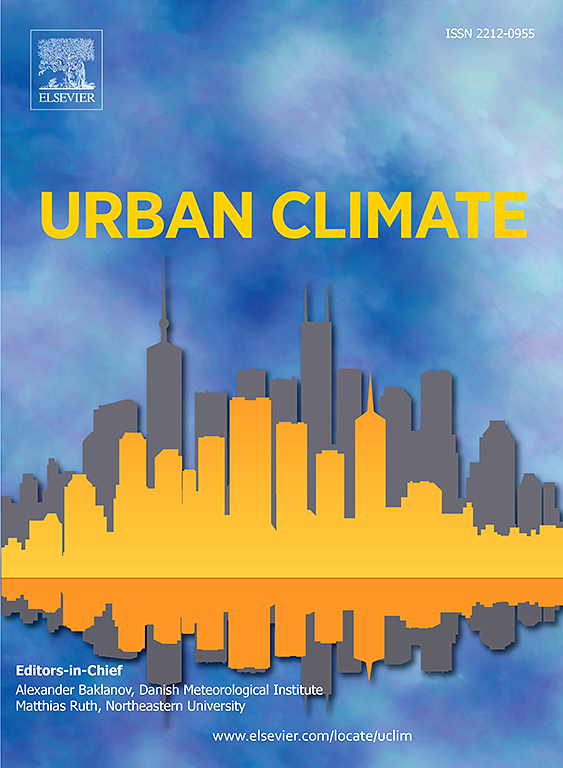不同城市发展模式下大气CO2浓度时空动态解析
IF 6.9
2区 工程技术
Q1 ENVIRONMENTAL SCIENCES
引用次数: 0
摘要
目前的研究缺乏从时空角度对城市XCO2动态和碳源/汇识别的精细尺度评估。为此,利用CatBoost模型和多源数据,结合时空因素,重构了2000 - 2020年中国大陆1 km分辨率XCO2数据集(XCO2_Cat)。它能够对XCO2和XCO2_ano进行深入分析,提供对碳源-汇动态的见解。在此基础上,提出了基于XCO2和XCO2_ano的碳风险识别矩阵来识别城市碳风险。结果表明,中国的XCO2呈东高西低的显著时空差异,以2 ~ 3 ppm/年的速率增加。各城市模型的XCO2和XCO2_ano均存在异质性。发展中城市的XCO₂含量最高。潜在收缩、持续收缩和智能收缩城市的XCO2值较低,但仍表现出较高的值,表明城市收缩并不一定导致脱碳。增长中的城市在大多数年份显示出最高的二氧化碳排放量。持续萎缩的城市最初表现出较高的碳源强度。在XCO2和XCO2_ano中发现了显著的区域异质性,强调需要针对区域的碳减排策略。基于碳风险识别矩阵将城市划分为4种类型:hl型(稳定碳源和受限碳汇)、lh型(碳源和受限碳汇)、hh型(强干扰)和ll型(弱碳源)。确定了各类型城市的重点区域和发展模式,并提出了针对性的碳管理策略。这些发现为在更精细的尺度上实施有效的碳减排政策提供了重要的指导。本文章由计算机程序翻译,如有差异,请以英文原文为准。
Decoding spatiotemporal dynamic of atmospheric CO2 concentration under different urban development model
Current research lacks fine-scale assessments of urban XCO2 dynamics and carbon source/sink identification from spatiotemporal perspectives. Thus, a 1 km-resolution XCO2 dataset (XCO2_Cat) for mainland China from 2000 to 2020 was reconstructed using CatBoost model and multi-source data, incorporating spatial and temporal factors. It enabled an in-depth analysis of XCO2 and XCO2_ano, offering insights into carbon source-sink dynamics. Furthermore, a carbon risk identification matrix based on XCO2 and XCO2_ano was proposed to identify urban carbon risks. Results revealed significant spatiotemporal variations in China, with higher XCO2 in the east and lower in the west, increasing at a rate of 2–3 ppm/year. Heterogeneity in XCO2 and XCO2_ano was observed across urban models. Growing cities had the highest XCO₂ levels. Potentially shrinking, continuously shrinking and smart shrinking cities had lower XCO2, but still exhibited relatively high values, suggesting that urban shrinkage does not necessarily lead to decarbonization. Growing cities showing the highest XCO2_ano in most years. Continuously shrinking cities initially exhibited higher carbon source intensity. Substantial regional heterogeneities were found in XCO2 and XCO2_ano, emphasizing the need for region-specific carbon reduction strategies. Cities were categorized into four types based on carbon risk identification matrix: HL-type (stable carbon source and constrained carbon sink), LH-type (carbon source to carbon sink and vice versa), HH-type (strong disturbance), and LL-type (weaker carbon source). Key regions and urban development models for each type were identified, and targeted carbon management strategies were proposed. These findings offer critical guidance for implementing effective carbon reduction policies at finer scales.
求助全文
通过发布文献求助,成功后即可免费获取论文全文。
去求助
来源期刊

Urban Climate
Social Sciences-Urban Studies
CiteScore
9.70
自引率
9.40%
发文量
286
期刊介绍:
Urban Climate serves the scientific and decision making communities with the publication of research on theory, science and applications relevant to understanding urban climatic conditions and change in relation to their geography and to demographic, socioeconomic, institutional, technological and environmental dynamics and global change. Targeted towards both disciplinary and interdisciplinary audiences, this journal publishes original research papers, comprehensive review articles, book reviews, and short communications on topics including, but not limited to, the following:
Urban meteorology and climate[...]
Urban environmental pollution[...]
Adaptation to global change[...]
Urban economic and social issues[...]
Research Approaches[...]
 求助内容:
求助内容: 应助结果提醒方式:
应助结果提醒方式:


